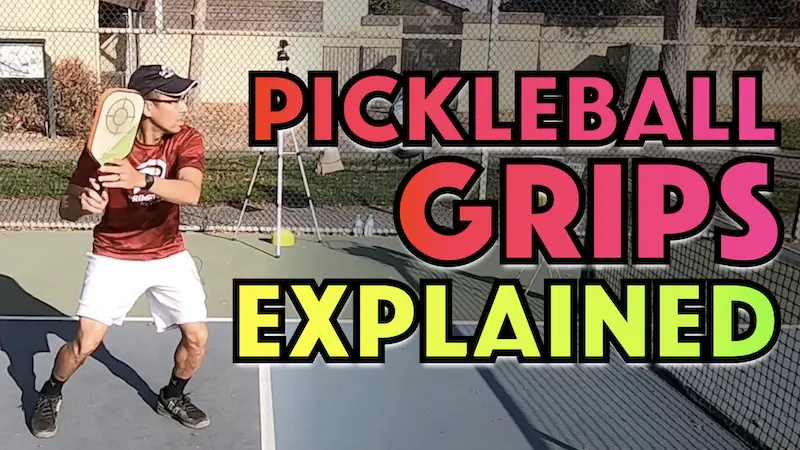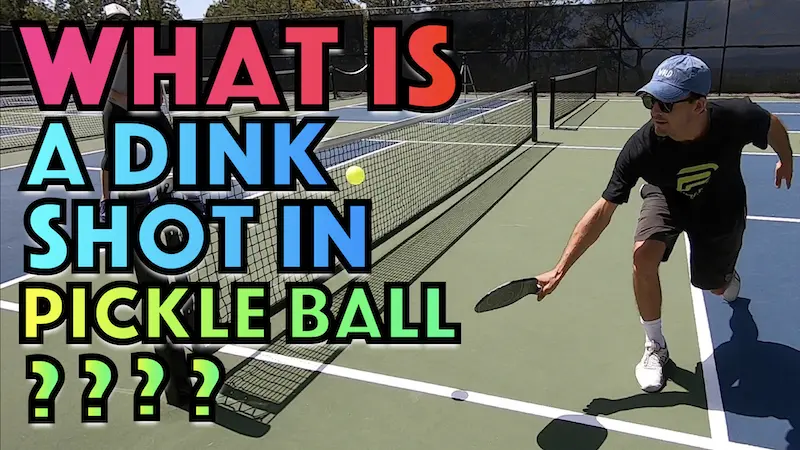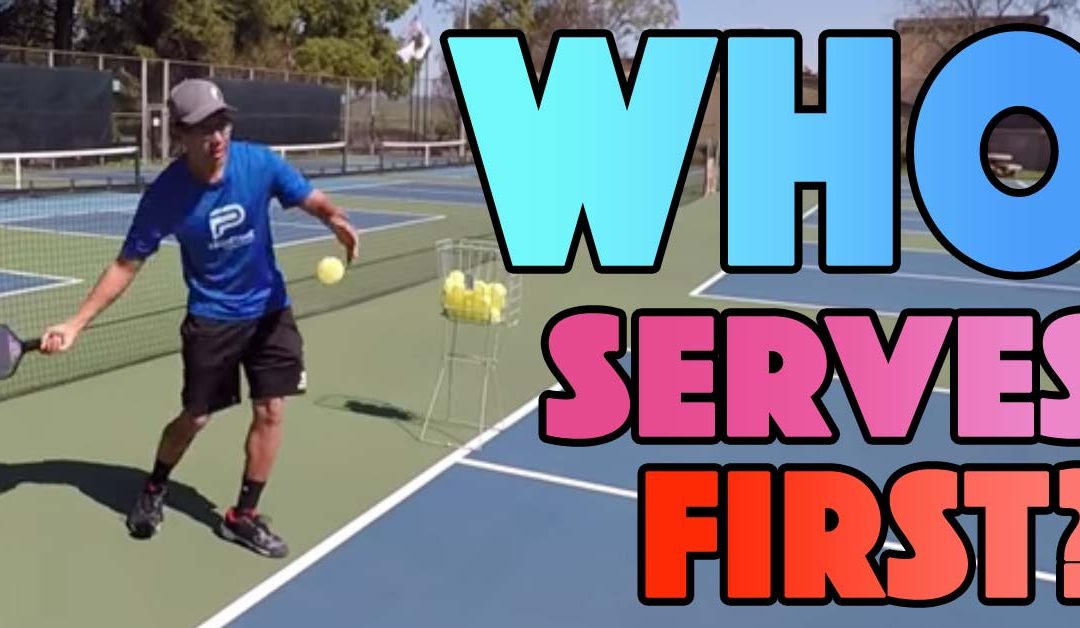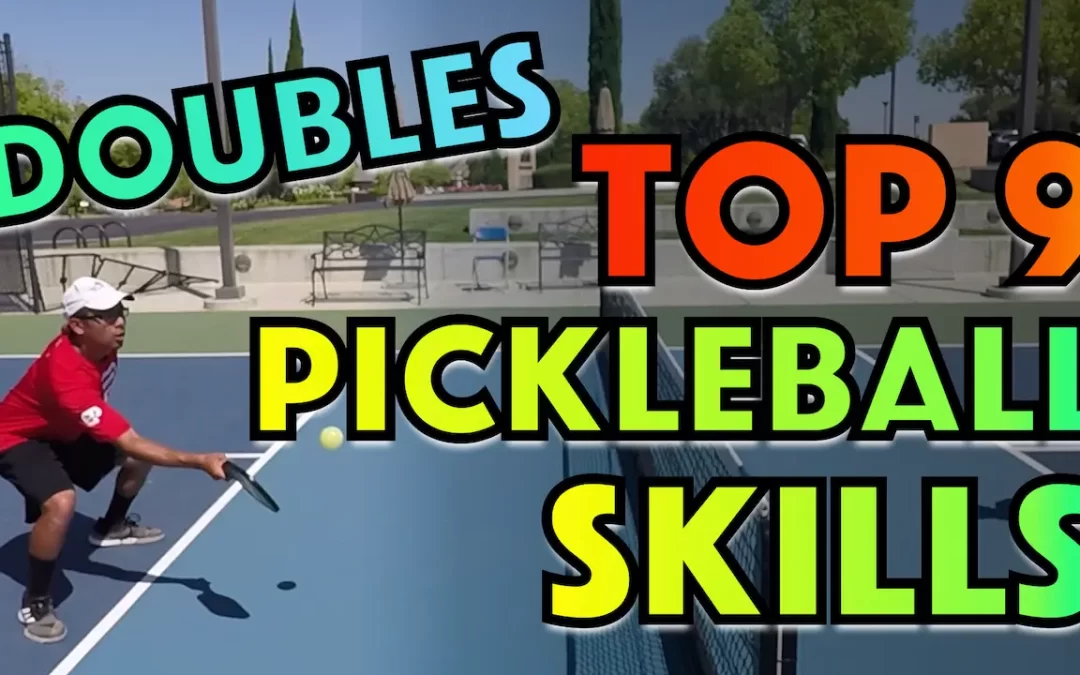You start the process of developing your unique playing style the first time you pick up a pickleball paddle.
Your style can be honed, amplified and improved by learning the proper pickleball hitting techniques. The enjoyment you get from each game then increases by leaps and bounds as your skill level increases.
If you have a background in tennis, table tennis, squash, badminton or any other paddle/racquet sport, mastering the various shots you need to become a well-rounded and competent player is easier. Though that doesn’t mean that true beginners, with no previous paddle experience, can’t improve quickly too.
They just need to spend more time practicing proper pickleball shots & techniques.
Why Are Proper Pickleball Hitting Techniques Necessary?
After you’ve spent some time playing pickleball, the rules become second nature and just about any pickleball player will naturally start to focus on learning hitting strategies and techniques.
While you can enjoy pickleball games without learning the proper techniques, it limits your ability to improve.
You’ll also find it increasingly difficult to play against more advanced players who’ve spent time learning and practicing the correct fundamentals of playing the game in an advanced way that tends to lead to more winning.
Learning the correct hitting techniques will consequently increase your enjoyment of the game. As you improve, you can perform at a higher level and face a more skilled opponent.
It becomes easier for you to make game-winning shots.
Your frustration levels decrease as you learn to position your body and select the right shot for the position and speed of the ball. You’ll instinctively place the ball in areas of the court making it difficult for your opponents to return the shot.
And ultimately, you will win more games which is good for you and your partner.
So, let’s look at some pickleball hitting tips.
What is The Best Way to Hit a Pickleball?
The best way to hit a pickleball depends on which shot you are attempting.
However, the basic technique of hitting a pickleball is best demonstrated by the one shot over which you have complete control; the serve.
With the serve, you get to control your stance, your swing, the toss, your contact point, ball speed, ball direction etc…
So how do you hit a pickleball serve correctly?
Key Tip: Hit With Your Whole Body
You must use your whole body to make the serve, and not just your arm and wrist. A strong, consistent serve results from using all the muscles in your body.
The power in your serve is generated by the contraction of the muscles in a chain reaction from your feet, up through your legs, into the twisting of your core muscles in your torso, and on into the shoulders, arms, and wrist.
For a traditional serve, starting in a neutral stance, your body position starts (for right-handed players) with your feet about shoulder width apart and your left foot ahead of your right foot and your left shoulder turned more forward towards the net.
Both legs should be bent at the knee as you turn your shoulders to take your paddle backward with your weight more loaded on the back (right) leg.
As you toss and start your motion, many players often make a small step forward with the left leg to transfer body weight into the shot. As you transfer your weight onto the left leg, you start to swing the paddle forward.
Your body will now be facing sideways (chest towards the side fence) with your arms spread wide. One arm is out forward tossing the ball. The other arm has the paddle back and is ready to start the swing.
When you start the downward movement of the paddle, you drop the ball from your left hand and crouch down slightly, coiling your body and using the uncoiling motion of your hips to power the arm through the stroke.
The paddle makes contact with the ball slightly ahead of your body and in a slight upward trajectory. You should allow your body to continue to move forward with a full follow-through of the paddle to a position above or around your left shoulder.
At the point of impact, you should be balanced with your weight shifted more towards the balls of your feet. No need to go up on your tippy toes. Heels relatively down and just have your weight in the front part of your foot. Finish the stroke by allowing your back leg to come forward as needed so that you end up in an evenly balanced ready position with your toes now both pointed forward in anticipation of the return..
Be sure to keep your head down and your eyes on the ball throughout the serve so that you make good contact with the ball. Only after your serve is done should your eyes look up to track the ball and be prepared to track the return.
Although you can hit the serve out of a more open stance, It is easier to generate more power if you start in a neutral stance. It’s easier for learning correct technique. Mater this before experimenting with other stances.
In an open stance starting position, though you will have your weight more over your hitting side leg to start, your feet will both be positioned in a line, up near the baseline as opposed to one in front of the other.
It requires a more advanced ability to understand how to still use the kinetic chain effectively out of this starting position which is why we don’t recommend it for new players or those still on the lower end of the pickleball hitting skills spectrum.
Out of the neutral stance, with your chest starting facing more sideways, you allow your body the room to rotate easily when striking the pickleball. The open or semi-open stance with your chest facing initially more open towards the net, it doesn’t give you enough room to fully power through your shot if you don’t understand how to do it correctly.
We can now look at how the serve corresponds to hitting other shots in pickleball.
Basics of How To Swing A Pickleball Paddle
When learning how to hit a pickleball, you need to consider your initial position, preparation for the shot, and ultimately how to hit the ball.
The Ready Position
Each pickleball stroke requires that you adopt the proper ready position so that you can move to setup well for your shot. Otherwise, your shot is doomed before it’s even begun.
The correct stance allows you to move in any direction quickly and easily.
Depending on your position on the pickleball court and where the ball is struck relative to where you are, you may have to move forward, to either side or backward.
As you’re assessing where your opponent is about to hit the ball and track it coming off their padde, balance is critical.
So you should have your weight forward over the balls of your feet and toes pointed forward so you’re ready to spring into action towards the ball. Your feet should be at least shoulder-width apart with the knees slightly bent so you’re ready to push off and head in any direction needed.
Your Swing
You can swing the paddle in one of two ways.
There’s the pendulum position, where the paddle hangs down and the tip of the paddle is pointed to the ground throughout the swing, and then there’s the lateral position, where the paddle tip is ultimately pointed in a range from directly towards the side at the point of contact or within 45 degrees up or down of that.
If you are new to the sport then using a pendulum swing is probably going to be easier for you to use at first but we do recommend transitioning to, or better yet starting with, a lateral motion.
A pendulum motion is extremely limiting for power and for adding spins and not useable at all for higher contact points.
A lateral motion will be needed if you hope to advance to high levels of play and possess advanced in your arsenal of shots.
Players with a background in tennis or racquetball will already have a lateral swing as part of their game so it’s best for them to stick with that.
Hitting techniques when you’re at the NVZ line
One you advance from the back court up to play at the non-volley zone line, volleys and dink dominate play at that stage of the point.
Pickleball, like any other sport is a ground war. You want to be up in the court so you have the most access to your opponents court and they have the least amount of access to yours.
From up their you can hit sharper angles and you cut off their shots to the baseline by taking them out of the air (volley).
The swing on dinks and punch volleys is short with minimal follow-through. The main thing to remember with these shots is that the paddle stays in the same orientation relative to the ball throughout most of the swing.
You will hit full swing shots (swinging volleys and overheads) when the opportunity presents itself but you will have to build to those chances with dinks and punch volleys.
Here are some techniques and strategies that you can use to help play a more aggressive and competitive pickleball game using basic strokes.
6 Pickleball Techniques & Strategies to Help You Win
1. Hitting Groundstrokes Smoothly
Ground strokes are hit when the ball bounces once after clearing the net.
You will use a groundstrokes most frequently on the return and when driving the ball from mid court when an offensive opportunity presents itself.
Once you advance up to the non-volley zone you will use a full motion groundstroke much more infrequently but it could and likely will still happen at times.
The technique of the forehands drive groundstroke is very similar to the serve.
To prepare yourself to hit an accurate shot, move to the ball quickly once you know where it’s headed. Be sure to give yourself enough space so that you can step forward as you initiate your swing so that your weight moves forward when you make contact with the ball while still having an in front contact.
Many players underestimate how much space they need and end up being too jammed on their shot.
On a forehand, in the case of a right-handed player, your right foot should set as much behind the ball as you have time to achieve. You’ll then step into the shot with your left foot. This gives your body room to rotate as you make the swing and you will lead the swing with the palm of your hand.
On a backhand (in the case of a righty), you will set the left foot as the back foot and step in with the right foot and lead the shot with your knuckles.
When hitting the pickleball, you want to be as smooth as possible. This is achieved with a relaxed swing and a “not too tight” grip. This gives you the power to hit deep shots with ease. With enough practice you can hit these shots with a lot of confidence.
2. Forehands For The Win
The forehand side is generally the more powerful and stable side for most players simply because hitting while leading with the palm of your hand is easier than leading with the knuckles.
The forehand drive motion, which can be used on a groundstroke or a swinging volley, is the most powerful shot in pickleball right after the overhead. However it is hit far, far more frequently than the overhead which is what makes it the most useful and dangerous shot in the game of pickleball.
On a forehand drive, you will usually take the paddle back about shoulder high and then drop into the swing from there.
Coming into contact your shot will be headed on an, at least slightly, upward trajectory. Many refer to this part of the motion as low to high. When you make contact with the ball, imagine hitting through 3 balls lined up in the direction of your shot before coming around for the finish over your opposite shoulder. Many players tend to stop short before getting fully through the shot limiting the power potential of their shot.
This way you will get into the habit of striking the ball with a loose, smooth, and full motion.
3. Hitting Backhands With The Right Grip
As mentioned above, many players prefer their forehand. Therefore, many players, including myself, are typically in their ready position in a forehand grip when at the baseline.
As a result, many players don’t get into a good grip for backhand if it’s not well trained. They hit their backhand using a grip that is optimized for the forheand.
Not good! Let’s fix that.
Backhands are way easier to hit if you have the correct grip. You can use the continental grip.
The continental grip is made with the “V” made by your thumb and index finger on top of the paddle, in line with the edge of the paddle.
Many times it will make sense to hit a backhand drive with a continental grip when you’re short on time and you definitely want to use it on a slice. It is the best grip for a slice backhand.
The best grip for a backhand drive, whether you hit it flat or with some topspin is the eastern backhand grip. For this grip yo simply rotate your hand about an inch left from continental (if you’re a righty) so that you index knuckle is inline with the paddle edge.
Next, you must be in the correct position relative to the ball. Move to the ball quickly once you know where it is going and get your left foot (if you’re a righty) as much behind the incoming ball as you can. Turn your shoulder a lot, more than you think, and get your right shoulder pointing at the ball. Your back should be slightly visible to your opponent. That’s how much you need to turn. This allows you to generate power by uncoiling your hips & shoulders using the power of your core muscles to swing through the ball.
Practice meeting the ball at a comfortable distance away from your body so that you are neither leaning too far forward nor receiving the ball close into your body. Aim for a comfortable, balanced stance leaning slightly forward towards the ball.
You’ll want to contact the ball with your paddle when it is slightly ahead of your body. Extend out and up to finish the shot.
4. Hitting Volleys For Defense & Offense
The volley is one a very common and useful shot in pickleball and is most often used when you are close to the non-volley zone line. Volleys can be hit hard or used in your soft game to pull players out of position.
Your aim is to strike the ball before it has a chance to bounce. You position yourself with your paddle in front of you with your knees slightly bent.
You need to be ready for both forehand and backhand volleys.
As the ball comes over the net you want to have your paddle facing the ball with the face slightly open. Keep the paddle face at the same angle throughout the shot. This helps you control the speed and direction of the ball.
You don’t need to swing at the ball, but rather hold the paddle out in front of you and make a punching motion towards the ball using mostly the shoulder as your hinge. Wrist and elbow movement should be minimal.
Aim to use the ball’s momentum to hit it back over the net when using a driving volley with the aim of keeping them back or hitting around them.
As you will normally be quite close to the kitchen when volleying, be sure to return the paddle to the ready position while you maintain a nicely balanced stance with your knees bent after making the shot.
Remember that there is very little follow-through as you need to get the paddle back into position for the follow-up shot.
Your contact point is slightly out in front of your body. Not too far that you have to straighten your arm to reach the ball and not so close to your body that the paddle is jammed up against you.
5. Hitting Dink Shot In or Near The Kitchen
The dink is made with the paddle face open and is designed to mostly fall within or near the non-volley zone as part of your soft game.
The continental grip will allow you to reach both forehands and backhands without changing your grip.
Your body position is very important as the ball is hit when it is low to the ground on a dink. You must bend your knees and aim to make contact with the ball slightly ahead of your body. Keep your knees bent with your feet just wider than shoulder-width apart.
There is very little movement in the swing as it is made with a short, upward movement of the paddle. It’s more of a nudge than a strike.
Aim to keep your follow-through short and compact. This allows you plenty of time to get back in position ready for the next shot.
6. Master The Spin & Slice
To impart spin both on the forehand and backhand shots requires a little practice before you can use it effectively in a game. This is an advanced shot that is a necessary as you move up in levels. First you should learn to slice to help keep the ball low. Later, when you have slice mastered, you can add topspin to your game.
Forehand Slice
To hit a forehand slice, you can practice against a wall first before taking it onto the court.
When hitting the ball against a wall, instead of just pushing the ball directly and hitting it very flush with your paddle face, try cutting the ball with a slightly high to low motion. Imagine you are in a sense “peeling” the surface of the ball off. This imparts a little bit of spin on the ball as the paddle essentially rubs across the surface of the ball.
Many make the mistake of making a big cut. Don’t do that, it’s only a slight adjustment to hitting it the way you normally would.
You’ll notice that the ball no longer comes straight back to you but rather comes off the wall at an angle due to the spin.
Once you’ve got the feel of imparting the slice during practice you can try it during the game. Use it when you are close to the net and as an addition to your normal dink.
Backhand Slice
In the same way that we described hitting the forehand slice, you’ll now try doing the same on the backhand side.
The same concepts of a slight hit to low motion and brushing the surface of the ball rather than making flush contact apply.
Always make sure that you still contact the ball slightly in front of your body with your knees slightly bent.
Final Thoughts
Remember that you must hit the ball using your entire body. Even, when you don’t intent to hit the ball very hard, still use your legs and body to control the swing. Too many players have a motion that relies far too heavily on just their arm.
The only way to improve in pickleball is to practice the techniques so that they become second nature.
Swinging from a balanced stance, with knees bent and swinging your paddle through the correct positions relative to your body and in harmony with your hitting style will enable you to hit winning shots while still being able to respond quickly to your opponent’s returns.
To learn how to improve the hitting technique of one of the most important shots in the game, the third shot drop, click here.






